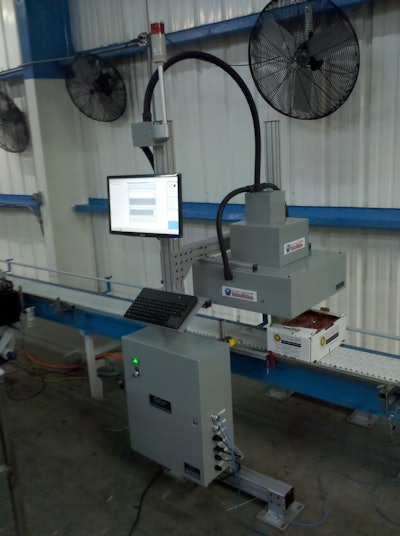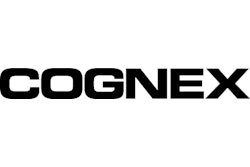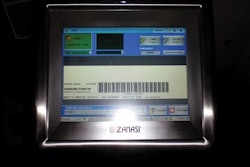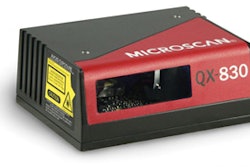The produce industry is moving to implement a systematic, industry-wide approach to closely track where fresh produce comes from and where it goes. One of the great challenges in this effort is the automatic recognition of a wide range of different package designs and hand stamps currently used to provide information about the produce. Sun Pacific, the largest grower, packer and marketer of citrus fruits in the United States, recently overcame this challenge by implementing the HarvestMark Product Traceability Initiative (PTI) solution with Saber Engineering VR-3000 vision inspection systems in several of its packing houses. These vision inspection systems utilize Cognex PatMax pattern recognition technology to consistently recognize case designs and hand stamps in spite of varying case positions and orientations, changes in ambient lighting, and other variables.
The produce industry handles an estimated 6 billion cases of produce in the United States each year. On very rare occasions, contaminated produce finds its way into the supply chain. The PTI is designed to identify the source of contaminated produce much faster and more accurately than is possible with conventional methods. The number one benefit is reducing the risk to consumers by ensuring that contaminated products are removed from the supply chain as quickly as possible. The PTI also has the potential for large cost savings by narrowing the impact of potential recalls and helping the supply chain resume normal operation much faster than is currently possible.
The PTI is based on a Global Trade Item Number (GTIN) that can be used for identifying trade items at all levels of packaging including item, case, and pallet. Under current best practices brand owners assign a 14-digit GTIN to every possible type of case based on the commodity, subtype, size, count, area of origin, grower, packer, etc. The GTIN along with the lot number is provided in human-readable form and encoded in a barcode on each case. Each subsequent handler then needs to have the capability to read and store the GTIN and lot number from each case of produce received. In case of a problem, this approach makes it possible to quickly trace goods through each handling step all the way back to their source.
But the produce industry faces challenges in achieving PTI compliance. Packers typically handle many different types of packages that are mixed together on their production lines. Often customers have their own case design and the produce is packed into many different customers’ cases in the packing plant. The workers in the packing line normally stamp the specifications such as the commodity, subtype, size, and count on the side of the case with a rubber stamp. The number one PTI compliance challenge for the packer is to automatically read the rubber stamp and identify the product associated with the package design and then automatically generate a label that contains all this information in both human-readable and 2D barcode format and affix it to the side of the case.
Saber Engineering developed the self-contained VR-3000 system that utilizes advanced machine vision technology to distinguish between the different types of packages and stamps with nearly perfect accuracy. The VR-3000 recognizes and verifies attributes such as type of shipping container, commodity, and size and passes this information to the HarvestMark database for processing. Trace-back, trace-forward and production data is securely hosted on the HarvestMark platform, delivering supply chain reporting and enabling on-demand traceability anywhere in the supply chain.
Saber Engineering’s vision solution uses a custom Visual Basic human machine interface (HMI) integrated with Cognex VisionPro vision tools to recognize package designs and stamps. The primary tool used is the PatMax part and feature location tool that uses advanced geometric pattern matching technology to reliably and accurately identify and locate patterns.
Pattern matching can be extremely challenging because many variables can alter the way an object appears to a vision system. Traditional pattern matching technology relies upon a pixel-grid analysis process commonly known as normalized correlation. This method looks for statistical similarity between a gray-level model or reference image of an object and portions of the image to determine the object’s X/Y position. Though effective in certain situations, this approach limits both the ability to find objects, and the accuracy with which they can be found, under conditions of varying appearance common to production lines, such as changes in object angle, size, and shading.
PatMax technology, on the other hand, learns an object’s geometry using a set of boundary curves that are not tied to a pixel grid, and then looks for similar shapes in the image without relying on specific gray levels. The result is a revolutionary improvement in the ability to accurately find objects despite changes in angle, size, and shading.
“We have tried all of the popular pattern recognition tools available,” said Dennis Hopkins, President of Saber Engineering. “PatMax works the best and none of the others even come close.”
Getting the lighting and camera angle right, also important for a successful vision application, can be difficult in a typical packing plant. Ambient lighting can change based on the position of the sun and cloud cover. The boxes are not precisely positioned on the line so they may be closer or further from the camera than expected and their orientation may also change. In many cases the camera needs to be able to read multiple sides of the box, for example, reading the hand stamp on one side of the box and artwork that indicated the type of package on another side. In this case, the camera needs to be oriented at an angle to the box so it can read multiple sides.
The VR-3000 uses an Ethernet camera with a 120 watt LED strobe light. “The light is very bright and diffuses well so it accommodates a lot of variance in box types,” Hopkins said. The system is designed for use in an industrial setting with a hand crank that provides 32 inches of vertical adjustment. The system can typically withstand up to 6 inches of misalignment without losing accuracy. It includes discrete I/O to communicate with a programmable logic controller (PLC) and an Ethernet output to communicate with the printer and the HarvestMark system.
Packers are continually adding different packages and stamps to their line. The VR-3000 makes it easy for operators to train the system to recognize new case designs and stamps simply by putting a box in front of the camera and pressing “learn” in the human machine interface (HMI). A picture of the box then appears on the HMI along with three windows superimposed on the box representing the area scrutinized by the PatMax inspection tools. The operator adjusts the tools so that they cover the areas that need to be inspected. These are typically distinctive design features that distinguish the case design and the stamp that indicates the subtype, size, and count of the produce. When Saber Engineering and HarvestMark install a new system, Saber characterizes the VR-3000 to handle all of the customer’s existing cases and stamps during the installation phase, while HarvestMark personnel perform the installation and training. In addition, Saber provides training to the new customer-designated employees on how to add additional cases and stamps for future changes to the production line.
Sun Pacific recently embarked on an initiative to achieve PTI compliance in its packing operations. The company set up a competition between Saber Engineering and another supplier of automated case identification and labeling solutions and ran them side by side for two months. Both solutions are designed to automatically recognize box artwork, stamps, and markings on cases of produce and, based on these, determine the GTIN associated with the box as it travels down the line at speeds up to 3,100 boxes per hour. The solution automatically generates the right label and applies it to the box at filling line speed.
In the competition, the VR-3000 read the customer’s boxes and stamps with a read rate of better than 99.5%. The only cases that were not read were those that the stamp was either missing or severely defaced. Based on the results of the competition, Sun Pacific ordered a total of 15 VR-3000 systems that are now deployed and operating in several packing houses located throughout central and southern California. “The customer tells us that the vision systems are performing extremely well,” Hopkins concluded.



























